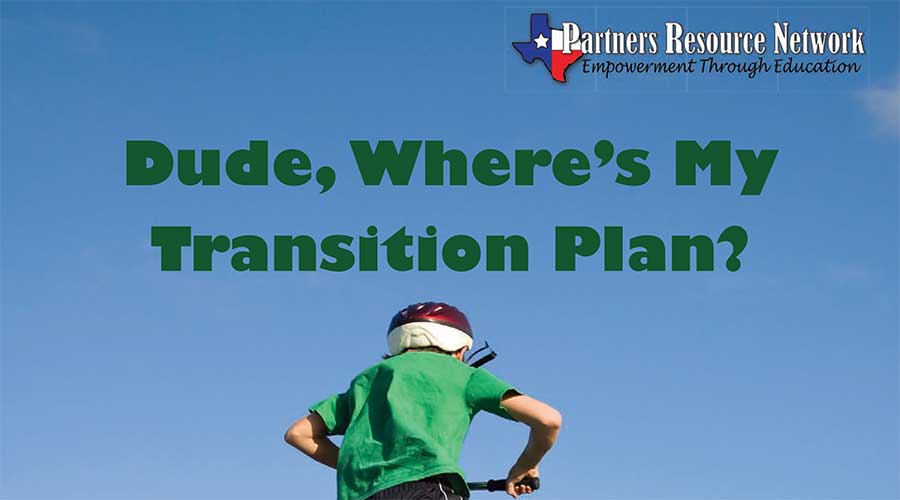Public school is the last mandated service that a student with a disability can access. After graduation, a person must apply to get services and supports and prove eligibility through income as well as disability. Public school is the last opportunity for free education, with a wide range of modifications and a requirement for parent input. Make the most of public school services as you plan for your youth’s transition to adulthood. Here are a few ideas to consider while you and your youth plan in the school setting:
Create a vision for the future. Ask for a planning session at school to discuss your youth’s future. Many districts have planning tools and interest/vocational inventories in place to help with this process. Invite your youth, family and friends, as well as relevant school staff, to your planning meeting. Be sure that you are clear on when your youth will graduate (ask staff to explain graduation options) and that your youth has a voice at the meeting.
Build a team with school staff. Find those people at your school and in your district who are knowledgeable and passionate about transition. These staff members might be teachers, administrators, family support personnel, job support personnel, or even related services providers. Also, note that every school district must designate a TED, a Transitionand Employment Designee; get to know that person in your district. Find your TED http://framework.esc18.net/display/Webforms/ESC18-FW-CountyInformation.aspx?ID=Transition
[rescue_box color=”blue” text_align=”left” width=”100%” float=”none”]Helpful tip: LEA = Your School District[/rescue_box]
Know what IDEA says about transition. Transition services as outlined in §300.43 of IDEA means a coordinated set of activities for a child with a disability that…
1. Is designed to be within a results-oriented process, that is focused on improving the academic and functional achievement of the child with a disability to facilitate the child’s movement from school to post-school activities, including post-secondary education, vocational education, integrated employment (including supported employment), continuing and adult education, adult services, independent living, or community participation;
2. And is based on the individual child’s needs, taking into account the child’s strengths, preferences, and interests; and includes:
- Instruction
- Related services
- Community experiences
- The development of employment and other post-school adult living objectives
- If appropriate, acquisition of daily living skills and provision of a functional vocational evaluation.
From https://www.autismspeaks.org/family-services/tool-kits/transition-tool-kit/why-transition-plan
Be sure your youth is involved as much as possible in the decision-making process and has input into all planning. Your son or daughter can learn how to be involved in the ARD/IEP process so that eventually he or she can perhaps lead the ARD meeting and help write goals, or at least be an active participant. Students who are less verbal can provide input through a communication device. The ARD meeting is a perfect opportunity for your youth to develop self-advocacy skills. For more information, Google student-led ARDs (for Texas examples) and student-led IEP meetings (for examples outside Texas).
Be sure that your youth is gaining vocational skills and experience. Ideally, transition services include training and work experience on-campus and off-campus, and if appropriate, paid employment by graduation. Your school district can bring in a Texas Workforce Commission (TWC) transition specialist by age 14 to support vocational exploration & training. (Note: DARS is now TWC.) http://www.twc.state.tx.us/jobseekers/vocational-rehabilitation-youth-students
Help the school staff to connect with businesses and non-profits in the community where students can find work experience. Remember that transportation may be an important factor after graduation; make sure that work opportunities are located in the community where your youth can access them (car, bus, carpool, other) when the school can no longer provide transportation. https://www.txp2p.org/services/services-for-parents-pathway-to-adulthood/life-after-graduation
If your youth will stay in school after age 18, find out what your school district provides for students between ages 18 and 22. Be sure that any 18+ program is truly focused on what a person will do after graduation, not just a re-hash of what he or she has been doing for the last 4 years of high school. Use this opportunity so that your youth is ready for the first day after graduation. NOTE: Students who receive modified content in at least one course for state graduation credit are eligible to continue for services after meeting credit and assessment requirements for graduation. Ask your ARD committee when eligibility for FAPE (free and appropriate public education) will end. If your youth did not receive any modifications in course work, he or she will not be eligible for an 18+ program.
If your youth plans to go to college, learn about entrance requirements and what assistance is available at the college level. Start planning for college before 9th grade so that your youth is taking classes appropriate for college-bound students. Talk to your high school registrar and visit college campuses; check on campus supports and services; learn about Section 504, since IDEA only applies to public school. More information is available at: https://www.navigatelifetexas.org/en/transition-to-adulthood/college-and-alternatives-for-students-with-disabilities
Be sure that you are planning for all aspects of life. For example, the school years are the ideal time to be sure you have built connections with other students and families for the future; it can be hard to find friends after graduation. Social skills will be an important factor in employment, dorm living, sharing a home, as well as building community; address these skills in the IEP. You can address funding and employment supports in the IEP and make connections with support agencies at ARD meetings.
Use these valuable resources:
- The Texas Transition and Employment Guide provides information on statewide services and programs that assist students with disabilities in the transition to life outside of the public school system.
- A Legal Framework addressing Transition Services is available from ESC 18.
- The Texas Project First website provides parents with information about Special Education in Texas. On the site’s home page, parents will find information most relevant to the age group of their youth. Transition topics can be found under Age Ranges 11-16 and 17-21.
- Navigatelifetexas.org is a comprehensive website for Texas families of children and youth with special needs.
- Texas Parent to Parent has a Pathways to Adulthood program that provides workshops statewide (see www.txp2p.org for current schedule); 1-1 assistance to families (Toll Free: 866-896-6001 and Austin: 512-458-8600); and a website with transition information on all major transition topics (Txp2p.org under Pathways to Adulthood).
This article by Rosemary Alexander, TXP2P Pathways to Adulthood Team – Summer 2017 Newsletter



